Strategic Planning Report: Analysis of Strategic Tools and Impact
VerifiedAdded on 2022/09/18
|10
|2064
|37
Report
AI Summary
This report delves into the realm of strategic planning, emphasizing its importance for organizations in developing effective strategies, evaluating their impact, and achieving operational efficiency. It highlights the application of various strategic management tools, including Porter's Five Forces, SWOT analysis, and PESTLE analysis. The report uses real-world examples like Zara, Adidas, and Nestle to illustrate how these tools can be used to analyze market dynamics, competitive positions, and macro-environmental factors. Porter's Five Forces is used to assess industry competition, while SWOT analysis examines internal strengths and weaknesses alongside external opportunities and threats. PESTLE analysis is applied to evaluate the broader political, economic, social, technological, environmental, and legal factors affecting business operations. The report concludes that strategic planning is crucial for achieving measurable goals, sustaining a competitive edge, and maximizing customer satisfaction. The application of these strategic tools helps businesses adapt to changing trends, overcome weaknesses, and capitalize on opportunities, ultimately leading to improved operational efficiency and long-term sustainability.
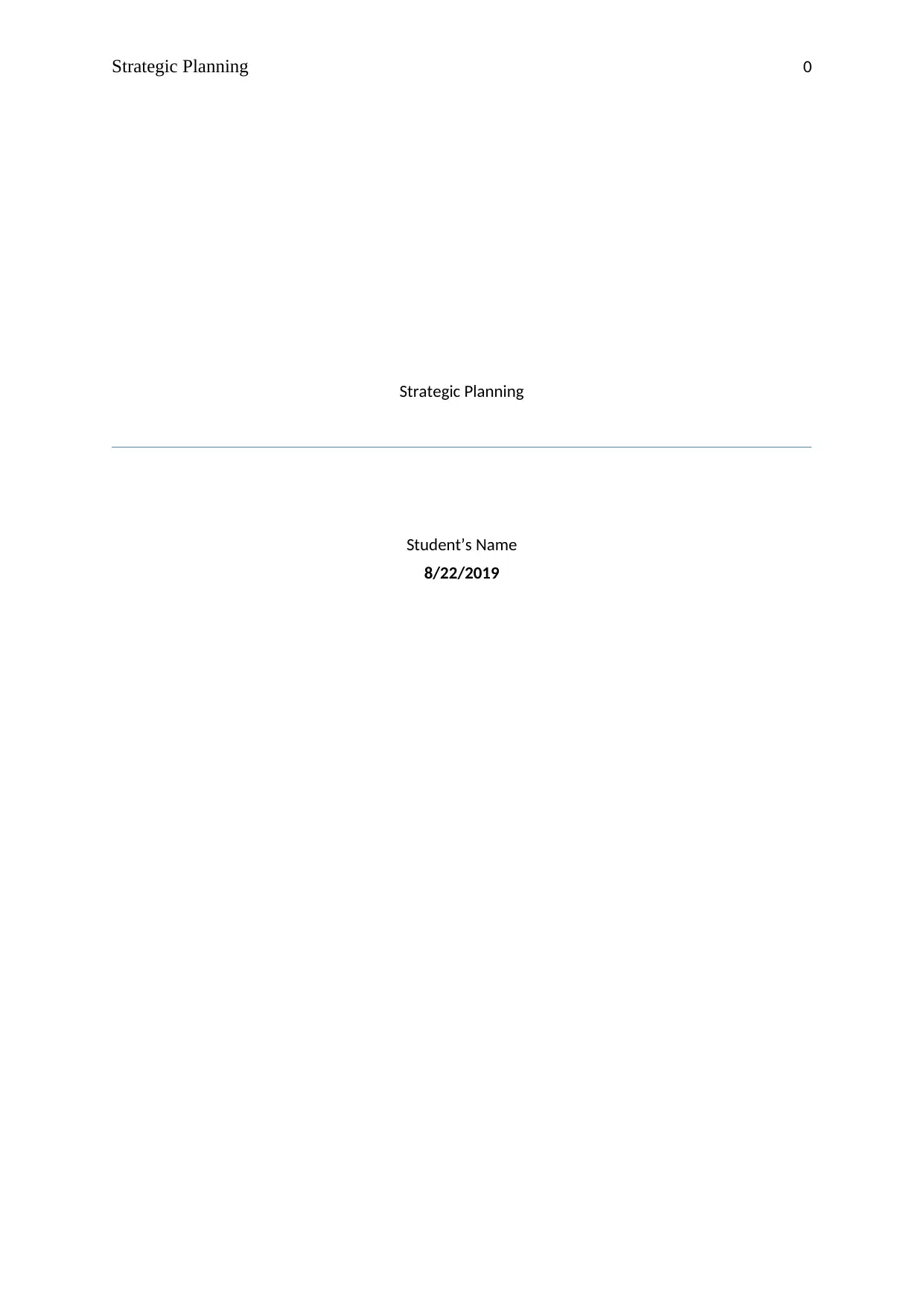
Strategic Planning 0
Strategic Planning
Student’s Name
8/22/2019
Strategic Planning
Student’s Name
8/22/2019
Paraphrase This Document
Need a fresh take? Get an instant paraphrase of this document with our AI Paraphraser
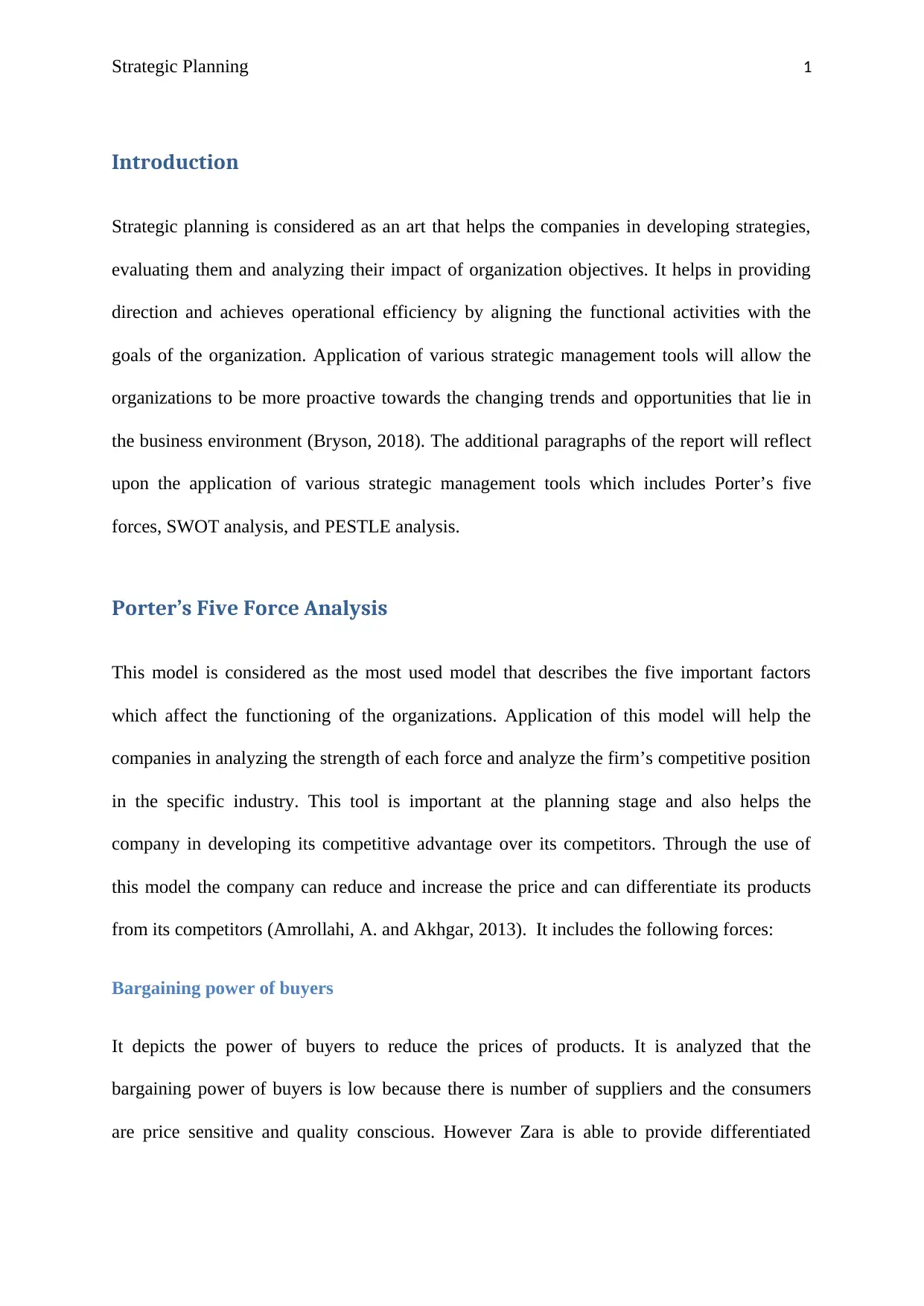
Strategic Planning 1
Introduction
Strategic planning is considered as an art that helps the companies in developing strategies,
evaluating them and analyzing their impact of organization objectives. It helps in providing
direction and achieves operational efficiency by aligning the functional activities with the
goals of the organization. Application of various strategic management tools will allow the
organizations to be more proactive towards the changing trends and opportunities that lie in
the business environment (Bryson, 2018). The additional paragraphs of the report will reflect
upon the application of various strategic management tools which includes Porter’s five
forces, SWOT analysis, and PESTLE analysis.
Porter’s Five Force Analysis
This model is considered as the most used model that describes the five important factors
which affect the functioning of the organizations. Application of this model will help the
companies in analyzing the strength of each force and analyze the firm’s competitive position
in the specific industry. This tool is important at the planning stage and also helps the
company in developing its competitive advantage over its competitors. Through the use of
this model the company can reduce and increase the price and can differentiate its products
from its competitors (Amrollahi, A. and Akhgar, 2013). It includes the following forces:
Bargaining power of buyers
It depicts the power of buyers to reduce the prices of products. It is analyzed that the
bargaining power of buyers is low because there is number of suppliers and the consumers
are price sensitive and quality conscious. However Zara is able to provide differentiated
Introduction
Strategic planning is considered as an art that helps the companies in developing strategies,
evaluating them and analyzing their impact of organization objectives. It helps in providing
direction and achieves operational efficiency by aligning the functional activities with the
goals of the organization. Application of various strategic management tools will allow the
organizations to be more proactive towards the changing trends and opportunities that lie in
the business environment (Bryson, 2018). The additional paragraphs of the report will reflect
upon the application of various strategic management tools which includes Porter’s five
forces, SWOT analysis, and PESTLE analysis.
Porter’s Five Force Analysis
This model is considered as the most used model that describes the five important factors
which affect the functioning of the organizations. Application of this model will help the
companies in analyzing the strength of each force and analyze the firm’s competitive position
in the specific industry. This tool is important at the planning stage and also helps the
company in developing its competitive advantage over its competitors. Through the use of
this model the company can reduce and increase the price and can differentiate its products
from its competitors (Amrollahi, A. and Akhgar, 2013). It includes the following forces:
Bargaining power of buyers
It depicts the power of buyers to reduce the prices of products. It is analyzed that the
bargaining power of buyers is low because there is number of suppliers and the consumers
are price sensitive and quality conscious. However Zara is able to provide differentiated
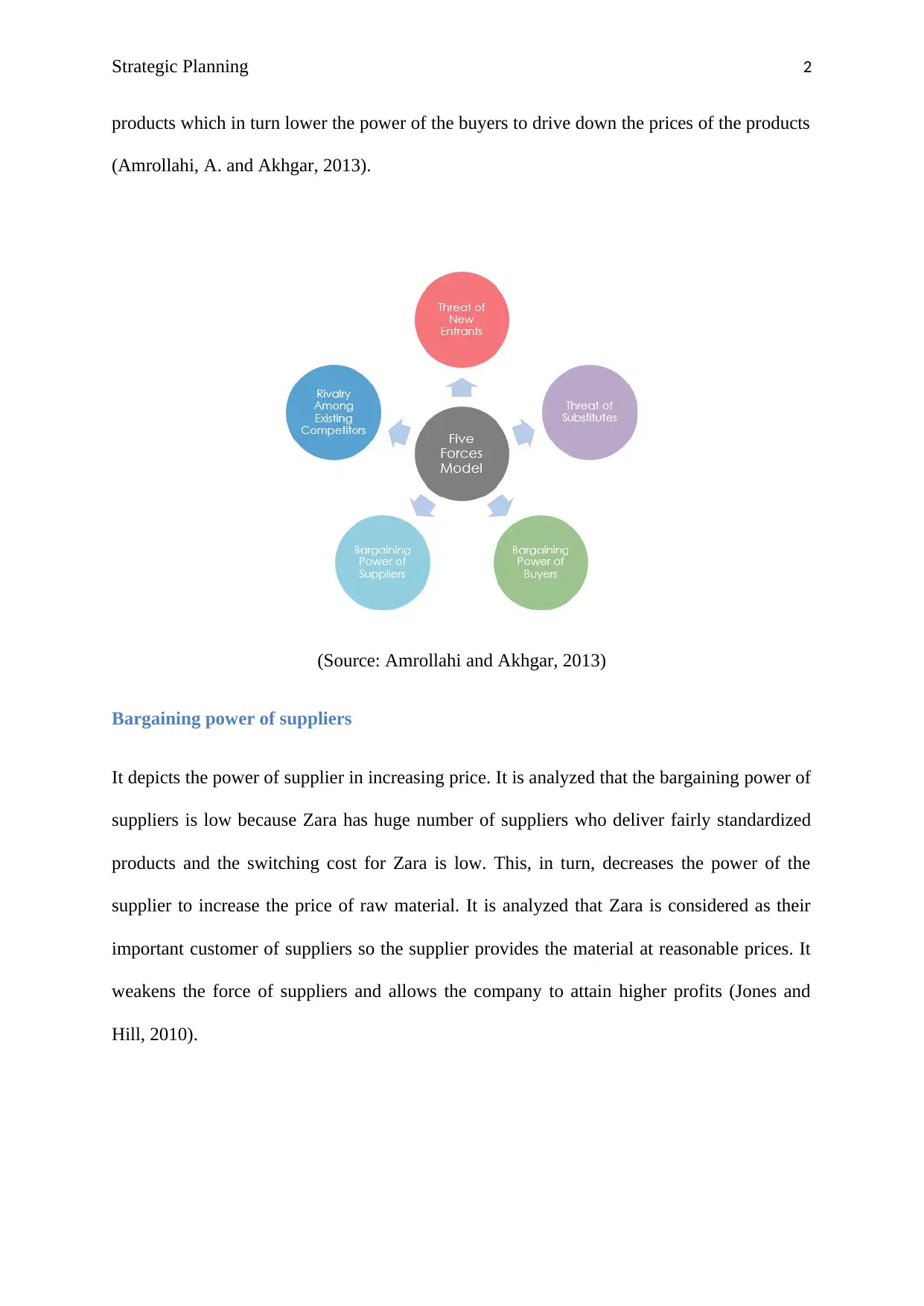
Strategic Planning 2
products which in turn lower the power of the buyers to drive down the prices of the products
(Amrollahi, A. and Akhgar, 2013).
(Source: Amrollahi and Akhgar, 2013)
Bargaining power of suppliers
It depicts the power of supplier in increasing price. It is analyzed that the bargaining power of
suppliers is low because Zara has huge number of suppliers who deliver fairly standardized
products and the switching cost for Zara is low. This, in turn, decreases the power of the
supplier to increase the price of raw material. It is analyzed that Zara is considered as their
important customer of suppliers so the supplier provides the material at reasonable prices. It
weakens the force of suppliers and allows the company to attain higher profits (Jones and
Hill, 2010).
products which in turn lower the power of the buyers to drive down the prices of the products
(Amrollahi, A. and Akhgar, 2013).
(Source: Amrollahi and Akhgar, 2013)
Bargaining power of suppliers
It depicts the power of supplier in increasing price. It is analyzed that the bargaining power of
suppliers is low because Zara has huge number of suppliers who deliver fairly standardized
products and the switching cost for Zara is low. This, in turn, decreases the power of the
supplier to increase the price of raw material. It is analyzed that Zara is considered as their
important customer of suppliers so the supplier provides the material at reasonable prices. It
weakens the force of suppliers and allows the company to attain higher profits (Jones and
Hill, 2010).
⊘ This is a preview!⊘
Do you want full access?
Subscribe today to unlock all pages.

Trusted by 1+ million students worldwide
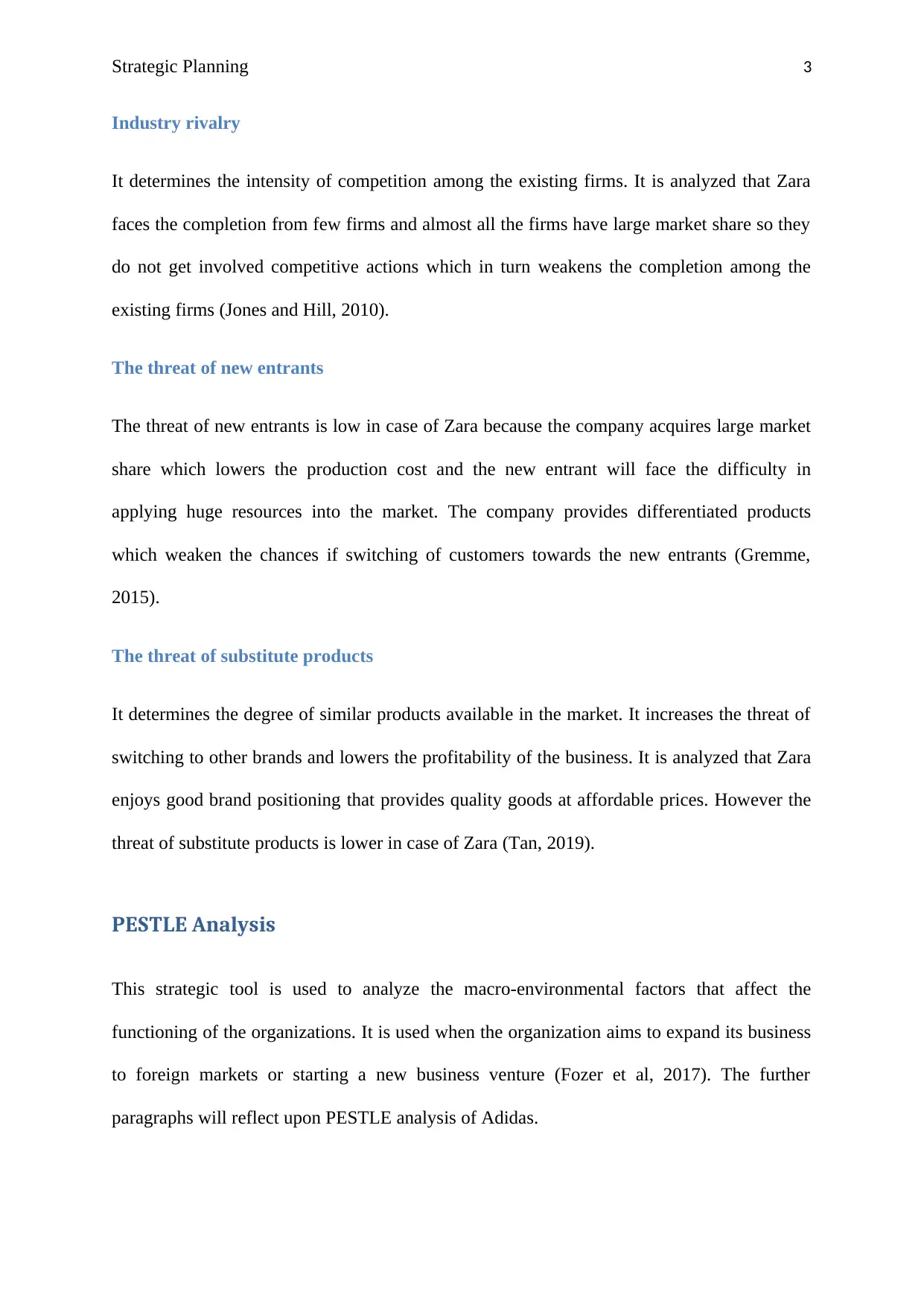
Strategic Planning 3
Industry rivalry
It determines the intensity of competition among the existing firms. It is analyzed that Zara
faces the completion from few firms and almost all the firms have large market share so they
do not get involved competitive actions which in turn weakens the completion among the
existing firms (Jones and Hill, 2010).
The threat of new entrants
The threat of new entrants is low in case of Zara because the company acquires large market
share which lowers the production cost and the new entrant will face the difficulty in
applying huge resources into the market. The company provides differentiated products
which weaken the chances if switching of customers towards the new entrants (Gremme,
2015).
The threat of substitute products
It determines the degree of similar products available in the market. It increases the threat of
switching to other brands and lowers the profitability of the business. It is analyzed that Zara
enjoys good brand positioning that provides quality goods at affordable prices. However the
threat of substitute products is lower in case of Zara (Tan, 2019).
PESTLE Analysis
This strategic tool is used to analyze the macro-environmental factors that affect the
functioning of the organizations. It is used when the organization aims to expand its business
to foreign markets or starting a new business venture (Fozer et al, 2017). The further
paragraphs will reflect upon PESTLE analysis of Adidas.
Industry rivalry
It determines the intensity of competition among the existing firms. It is analyzed that Zara
faces the completion from few firms and almost all the firms have large market share so they
do not get involved competitive actions which in turn weakens the completion among the
existing firms (Jones and Hill, 2010).
The threat of new entrants
The threat of new entrants is low in case of Zara because the company acquires large market
share which lowers the production cost and the new entrant will face the difficulty in
applying huge resources into the market. The company provides differentiated products
which weaken the chances if switching of customers towards the new entrants (Gremme,
2015).
The threat of substitute products
It determines the degree of similar products available in the market. It increases the threat of
switching to other brands and lowers the profitability of the business. It is analyzed that Zara
enjoys good brand positioning that provides quality goods at affordable prices. However the
threat of substitute products is lower in case of Zara (Tan, 2019).
PESTLE Analysis
This strategic tool is used to analyze the macro-environmental factors that affect the
functioning of the organizations. It is used when the organization aims to expand its business
to foreign markets or starting a new business venture (Fozer et al, 2017). The further
paragraphs will reflect upon PESTLE analysis of Adidas.
Paraphrase This Document
Need a fresh take? Get an instant paraphrase of this document with our AI Paraphraser
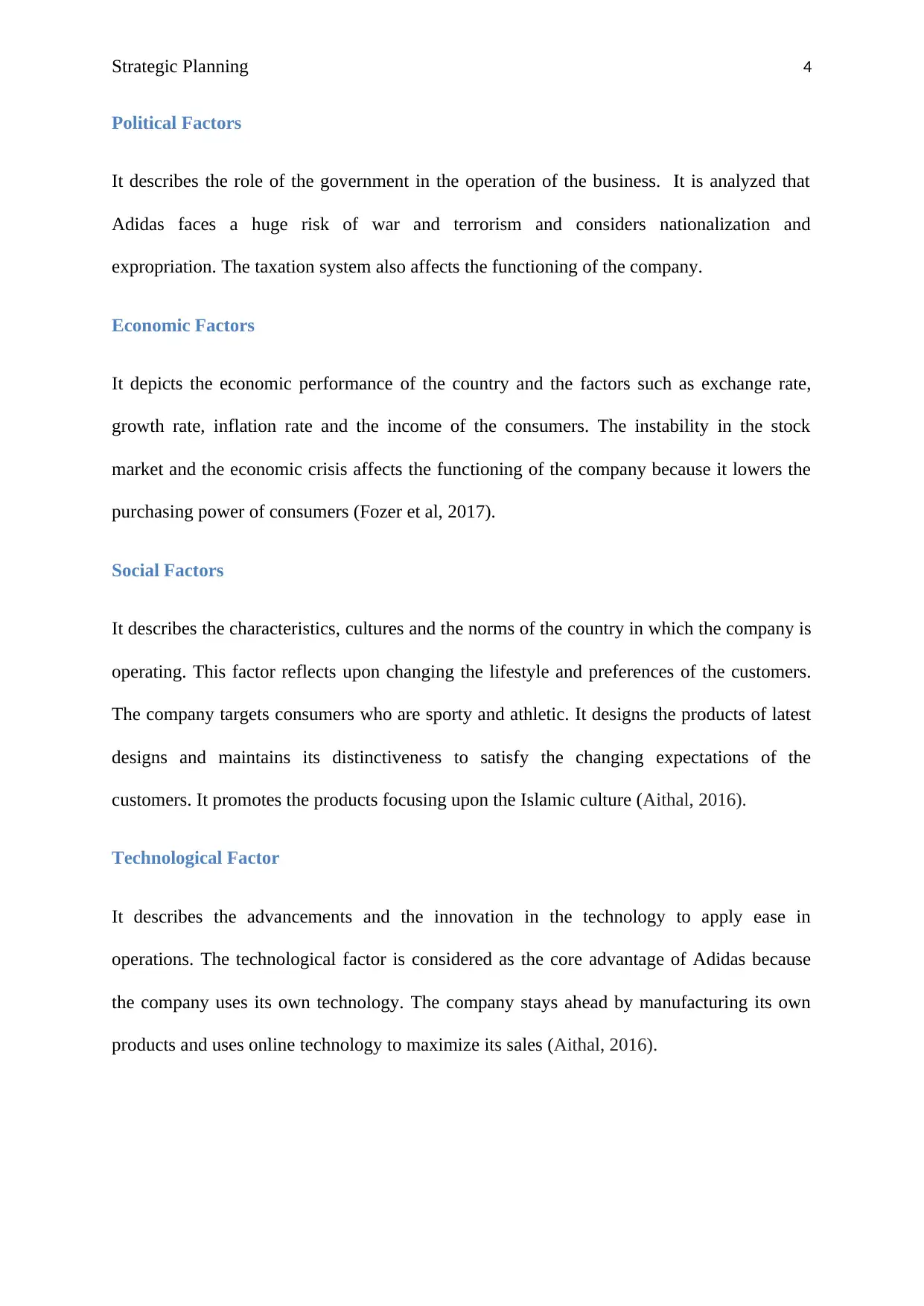
Strategic Planning 4
Political Factors
It describes the role of the government in the operation of the business. It is analyzed that
Adidas faces a huge risk of war and terrorism and considers nationalization and
expropriation. The taxation system also affects the functioning of the company.
Economic Factors
It depicts the economic performance of the country and the factors such as exchange rate,
growth rate, inflation rate and the income of the consumers. The instability in the stock
market and the economic crisis affects the functioning of the company because it lowers the
purchasing power of consumers (Fozer et al, 2017).
Social Factors
It describes the characteristics, cultures and the norms of the country in which the company is
operating. This factor reflects upon changing the lifestyle and preferences of the customers.
The company targets consumers who are sporty and athletic. It designs the products of latest
designs and maintains its distinctiveness to satisfy the changing expectations of the
customers. It promotes the products focusing upon the Islamic culture (Aithal, 2016).
Technological Factor
It describes the advancements and the innovation in the technology to apply ease in
operations. The technological factor is considered as the core advantage of Adidas because
the company uses its own technology. The company stays ahead by manufacturing its own
products and uses online technology to maximize its sales (Aithal, 2016).
Political Factors
It describes the role of the government in the operation of the business. It is analyzed that
Adidas faces a huge risk of war and terrorism and considers nationalization and
expropriation. The taxation system also affects the functioning of the company.
Economic Factors
It depicts the economic performance of the country and the factors such as exchange rate,
growth rate, inflation rate and the income of the consumers. The instability in the stock
market and the economic crisis affects the functioning of the company because it lowers the
purchasing power of consumers (Fozer et al, 2017).
Social Factors
It describes the characteristics, cultures and the norms of the country in which the company is
operating. This factor reflects upon changing the lifestyle and preferences of the customers.
The company targets consumers who are sporty and athletic. It designs the products of latest
designs and maintains its distinctiveness to satisfy the changing expectations of the
customers. It promotes the products focusing upon the Islamic culture (Aithal, 2016).
Technological Factor
It describes the advancements and the innovation in the technology to apply ease in
operations. The technological factor is considered as the core advantage of Adidas because
the company uses its own technology. The company stays ahead by manufacturing its own
products and uses online technology to maximize its sales (Aithal, 2016).
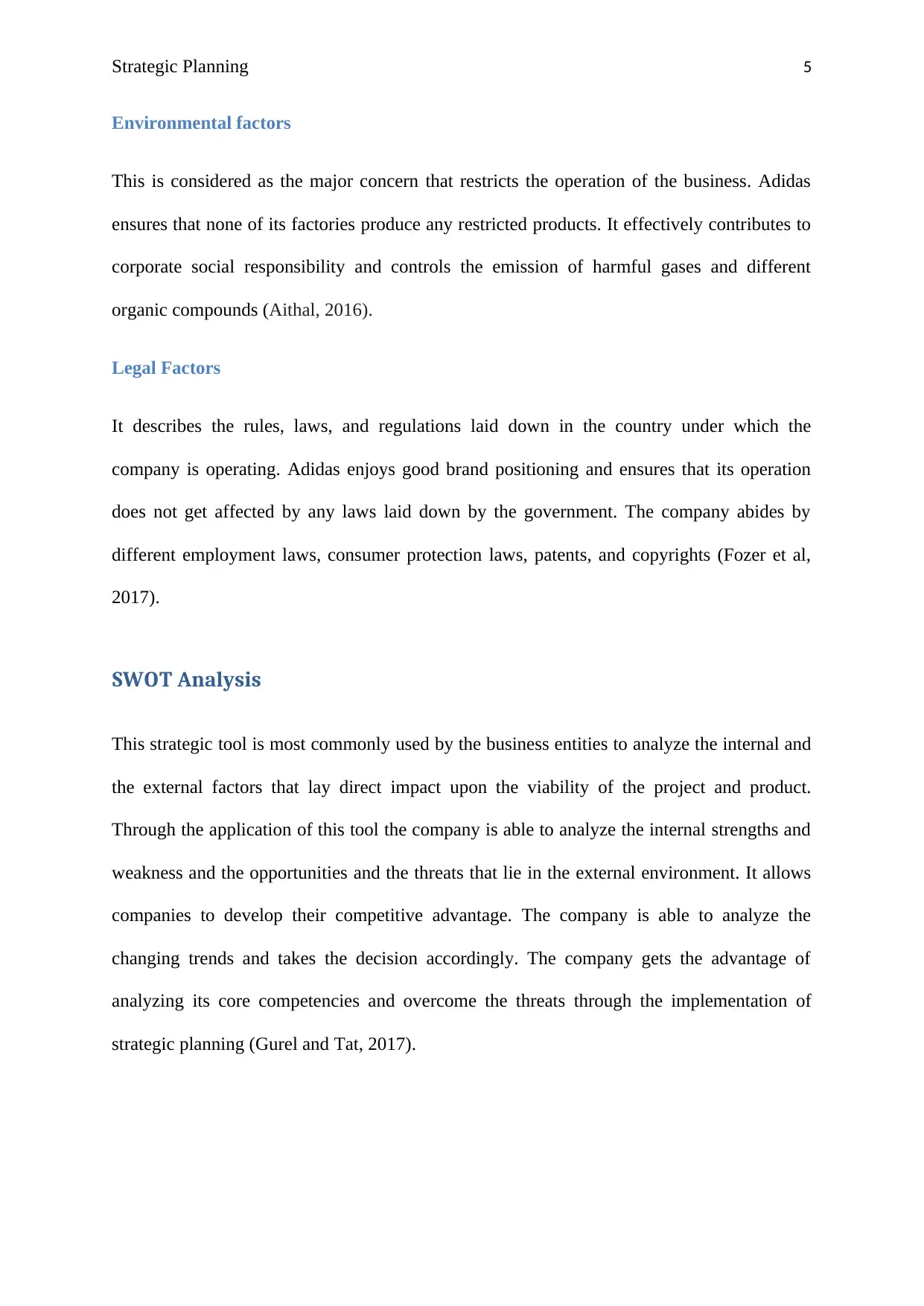
Strategic Planning 5
Environmental factors
This is considered as the major concern that restricts the operation of the business. Adidas
ensures that none of its factories produce any restricted products. It effectively contributes to
corporate social responsibility and controls the emission of harmful gases and different
organic compounds (Aithal, 2016).
Legal Factors
It describes the rules, laws, and regulations laid down in the country under which the
company is operating. Adidas enjoys good brand positioning and ensures that its operation
does not get affected by any laws laid down by the government. The company abides by
different employment laws, consumer protection laws, patents, and copyrights (Fozer et al,
2017).
SWOT Analysis
This strategic tool is most commonly used by the business entities to analyze the internal and
the external factors that lay direct impact upon the viability of the project and product.
Through the application of this tool the company is able to analyze the internal strengths and
weakness and the opportunities and the threats that lie in the external environment. It allows
companies to develop their competitive advantage. The company is able to analyze the
changing trends and takes the decision accordingly. The company gets the advantage of
analyzing its core competencies and overcome the threats through the implementation of
strategic planning (Gurel and Tat, 2017).
Environmental factors
This is considered as the major concern that restricts the operation of the business. Adidas
ensures that none of its factories produce any restricted products. It effectively contributes to
corporate social responsibility and controls the emission of harmful gases and different
organic compounds (Aithal, 2016).
Legal Factors
It describes the rules, laws, and regulations laid down in the country under which the
company is operating. Adidas enjoys good brand positioning and ensures that its operation
does not get affected by any laws laid down by the government. The company abides by
different employment laws, consumer protection laws, patents, and copyrights (Fozer et al,
2017).
SWOT Analysis
This strategic tool is most commonly used by the business entities to analyze the internal and
the external factors that lay direct impact upon the viability of the project and product.
Through the application of this tool the company is able to analyze the internal strengths and
weakness and the opportunities and the threats that lie in the external environment. It allows
companies to develop their competitive advantage. The company is able to analyze the
changing trends and takes the decision accordingly. The company gets the advantage of
analyzing its core competencies and overcome the threats through the implementation of
strategic planning (Gurel and Tat, 2017).
⊘ This is a preview!⊘
Do you want full access?
Subscribe today to unlock all pages.

Trusted by 1+ million students worldwide
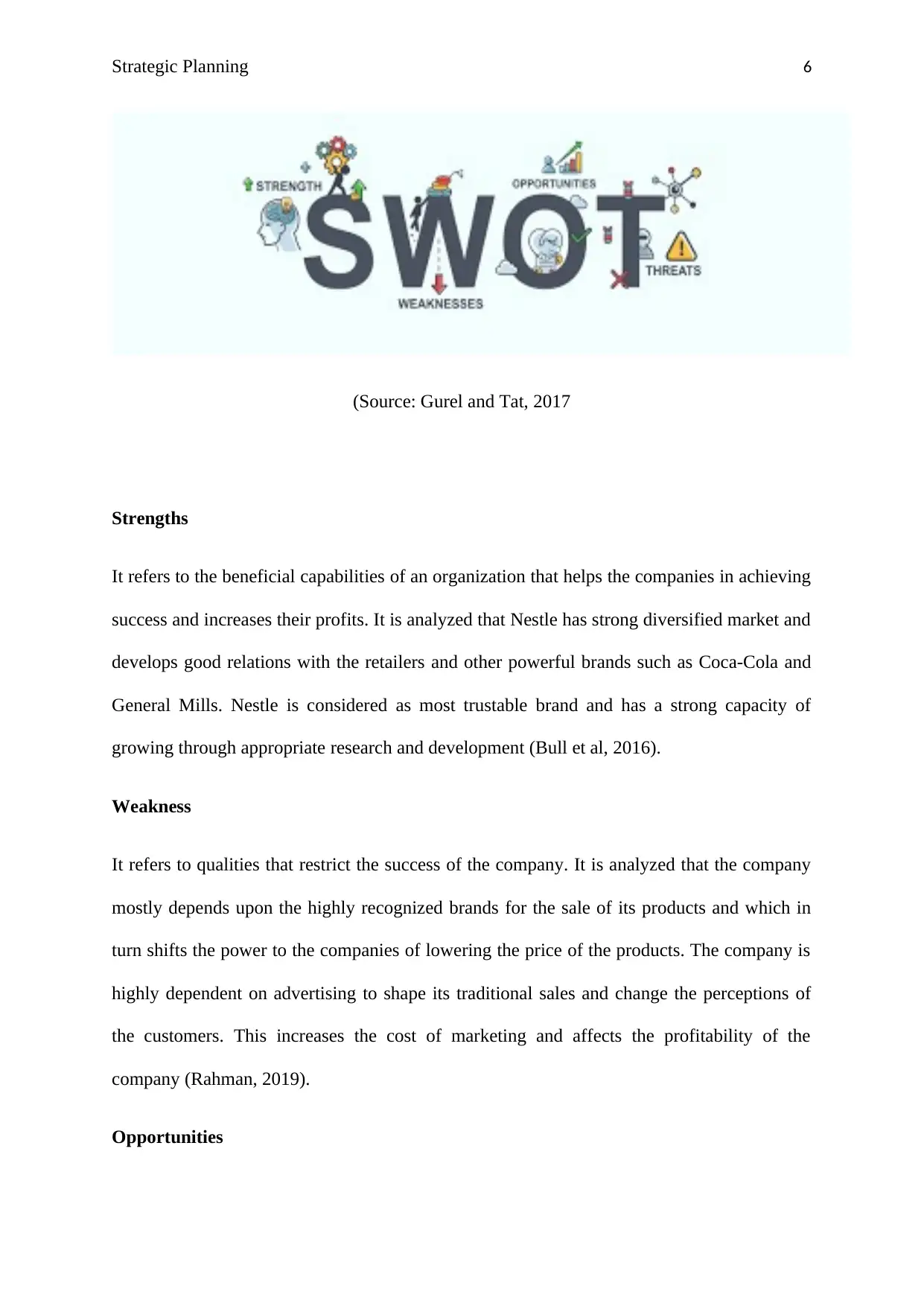
Strategic Planning 6
(Source: Gurel and Tat, 2017
Strengths
It refers to the beneficial capabilities of an organization that helps the companies in achieving
success and increases their profits. It is analyzed that Nestle has strong diversified market and
develops good relations with the retailers and other powerful brands such as Coca-Cola and
General Mills. Nestle is considered as most trustable brand and has a strong capacity of
growing through appropriate research and development (Bull et al, 2016).
Weakness
It refers to qualities that restrict the success of the company. It is analyzed that the company
mostly depends upon the highly recognized brands for the sale of its products and which in
turn shifts the power to the companies of lowering the price of the products. The company is
highly dependent on advertising to shape its traditional sales and change the perceptions of
the customers. This increases the cost of marketing and affects the profitability of the
company (Rahman, 2019).
Opportunities
(Source: Gurel and Tat, 2017
Strengths
It refers to the beneficial capabilities of an organization that helps the companies in achieving
success and increases their profits. It is analyzed that Nestle has strong diversified market and
develops good relations with the retailers and other powerful brands such as Coca-Cola and
General Mills. Nestle is considered as most trustable brand and has a strong capacity of
growing through appropriate research and development (Bull et al, 2016).
Weakness
It refers to qualities that restrict the success of the company. It is analyzed that the company
mostly depends upon the highly recognized brands for the sale of its products and which in
turn shifts the power to the companies of lowering the price of the products. The company is
highly dependent on advertising to shape its traditional sales and change the perceptions of
the customers. This increases the cost of marketing and affects the profitability of the
company (Rahman, 2019).
Opportunities
Paraphrase This Document
Need a fresh take? Get an instant paraphrase of this document with our AI Paraphraser
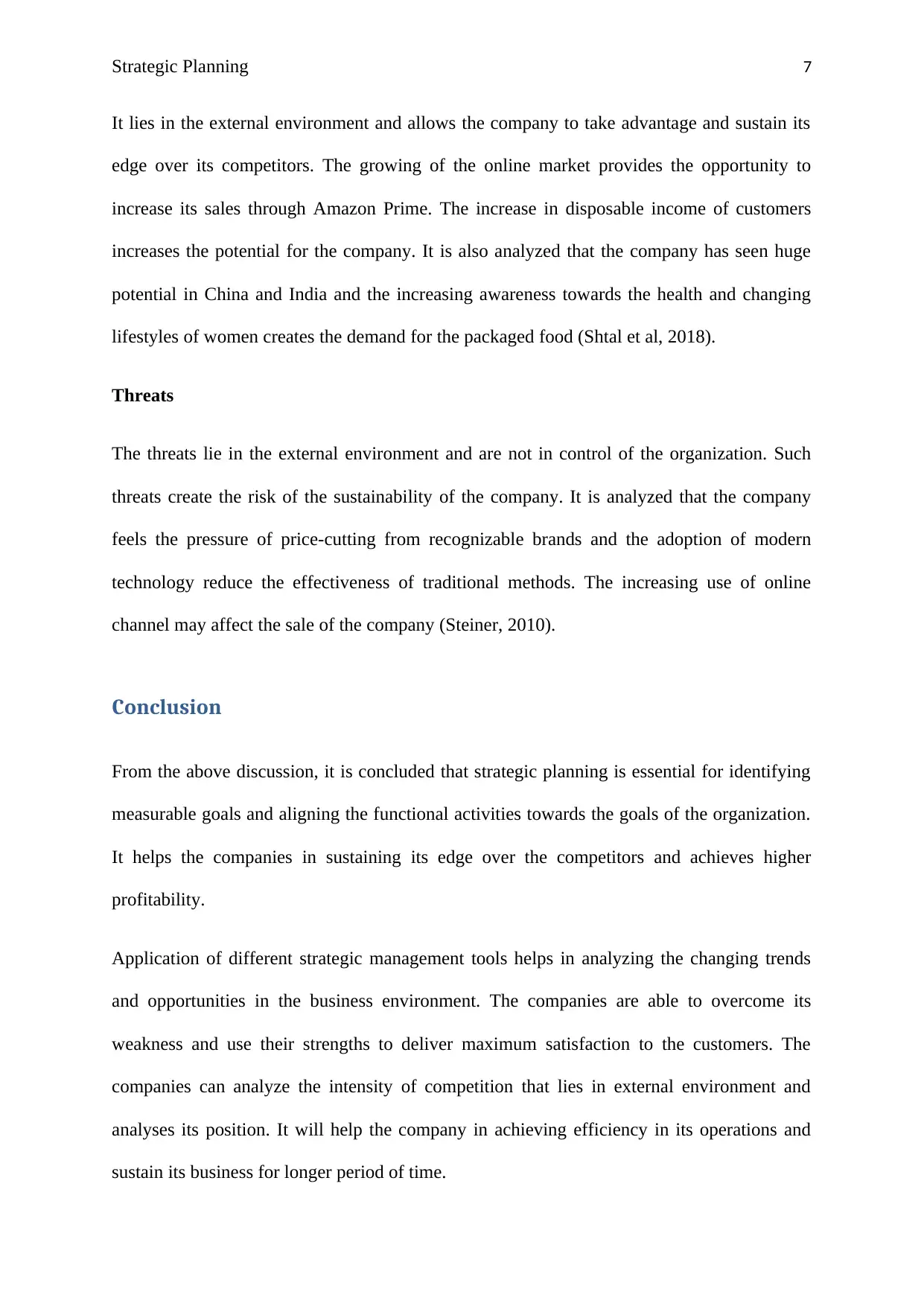
Strategic Planning 7
It lies in the external environment and allows the company to take advantage and sustain its
edge over its competitors. The growing of the online market provides the opportunity to
increase its sales through Amazon Prime. The increase in disposable income of customers
increases the potential for the company. It is also analyzed that the company has seen huge
potential in China and India and the increasing awareness towards the health and changing
lifestyles of women creates the demand for the packaged food (Shtal et al, 2018).
Threats
The threats lie in the external environment and are not in control of the organization. Such
threats create the risk of the sustainability of the company. It is analyzed that the company
feels the pressure of price-cutting from recognizable brands and the adoption of modern
technology reduce the effectiveness of traditional methods. The increasing use of online
channel may affect the sale of the company (Steiner, 2010).
Conclusion
From the above discussion, it is concluded that strategic planning is essential for identifying
measurable goals and aligning the functional activities towards the goals of the organization.
It helps the companies in sustaining its edge over the competitors and achieves higher
profitability.
Application of different strategic management tools helps in analyzing the changing trends
and opportunities in the business environment. The companies are able to overcome its
weakness and use their strengths to deliver maximum satisfaction to the customers. The
companies can analyze the intensity of competition that lies in external environment and
analyses its position. It will help the company in achieving efficiency in its operations and
sustain its business for longer period of time.
It lies in the external environment and allows the company to take advantage and sustain its
edge over its competitors. The growing of the online market provides the opportunity to
increase its sales through Amazon Prime. The increase in disposable income of customers
increases the potential for the company. It is also analyzed that the company has seen huge
potential in China and India and the increasing awareness towards the health and changing
lifestyles of women creates the demand for the packaged food (Shtal et al, 2018).
Threats
The threats lie in the external environment and are not in control of the organization. Such
threats create the risk of the sustainability of the company. It is analyzed that the company
feels the pressure of price-cutting from recognizable brands and the adoption of modern
technology reduce the effectiveness of traditional methods. The increasing use of online
channel may affect the sale of the company (Steiner, 2010).
Conclusion
From the above discussion, it is concluded that strategic planning is essential for identifying
measurable goals and aligning the functional activities towards the goals of the organization.
It helps the companies in sustaining its edge over the competitors and achieves higher
profitability.
Application of different strategic management tools helps in analyzing the changing trends
and opportunities in the business environment. The companies are able to overcome its
weakness and use their strengths to deliver maximum satisfaction to the customers. The
companies can analyze the intensity of competition that lies in external environment and
analyses its position. It will help the company in achieving efficiency in its operations and
sustain its business for longer period of time.
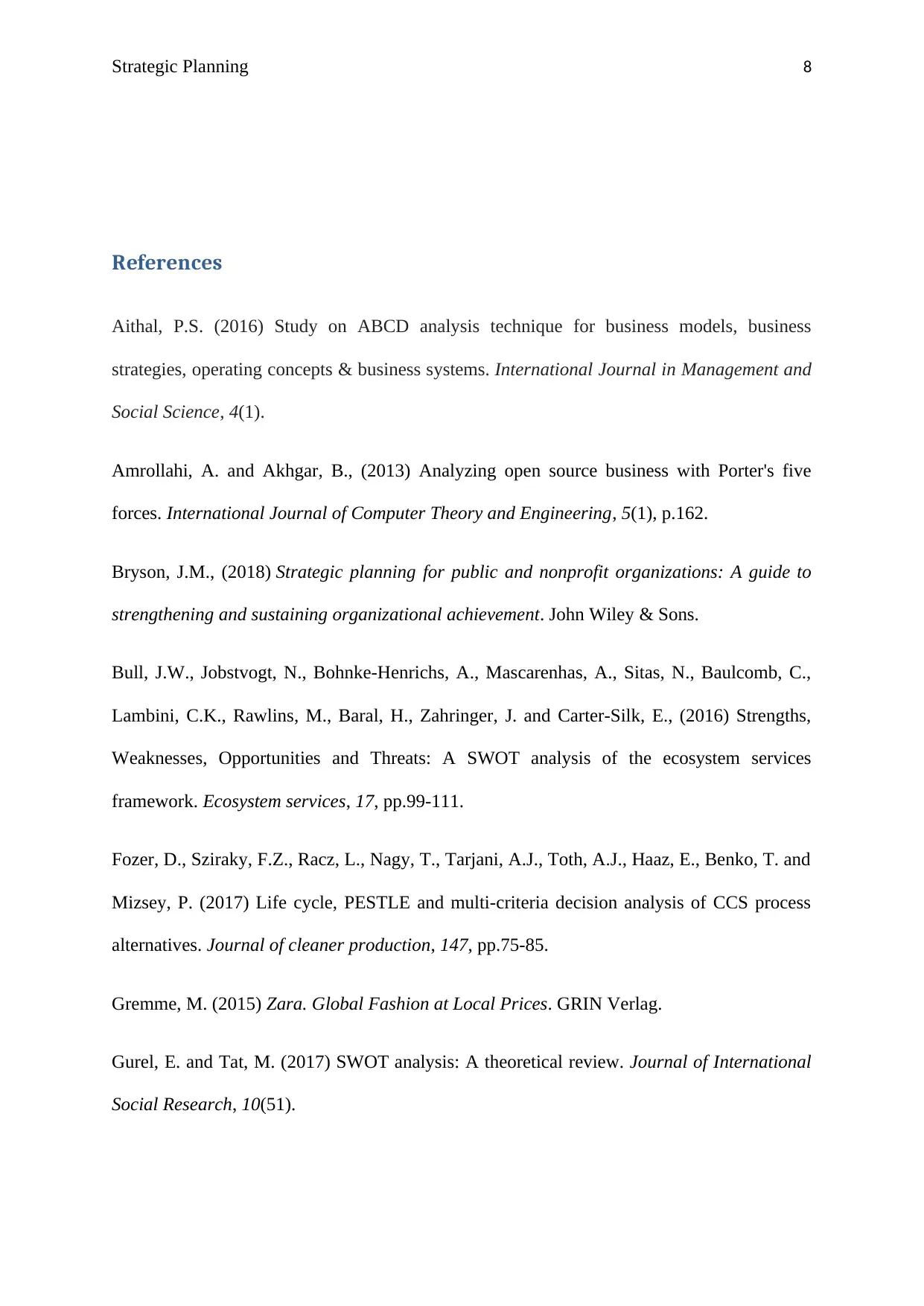
Strategic Planning 8
References
Aithal, P.S. (2016) Study on ABCD analysis technique for business models, business
strategies, operating concepts & business systems. International Journal in Management and
Social Science, 4(1).
Amrollahi, A. and Akhgar, B., (2013) Analyzing open source business with Porter's five
forces. International Journal of Computer Theory and Engineering, 5(1), p.162.
Bryson, J.M., (2018) Strategic planning for public and nonprofit organizations: A guide to
strengthening and sustaining organizational achievement. John Wiley & Sons.
Bull, J.W., Jobstvogt, N., Bohnke-Henrichs, A., Mascarenhas, A., Sitas, N., Baulcomb, C.,
Lambini, C.K., Rawlins, M., Baral, H., Zahringer, J. and Carter-Silk, E., (2016) Strengths,
Weaknesses, Opportunities and Threats: A SWOT analysis of the ecosystem services
framework. Ecosystem services, 17, pp.99-111.
Fozer, D., Sziraky, F.Z., Racz, L., Nagy, T., Tarjani, A.J., Toth, A.J., Haaz, E., Benko, T. and
Mizsey, P. (2017) Life cycle, PESTLE and multi-criteria decision analysis of CCS process
alternatives. Journal of cleaner production, 147, pp.75-85.
Gremme, M. (2015) Zara. Global Fashion at Local Prices. GRIN Verlag.
Gurel, E. and Tat, M. (2017) SWOT analysis: A theoretical review. Journal of International
Social Research, 10(51).
References
Aithal, P.S. (2016) Study on ABCD analysis technique for business models, business
strategies, operating concepts & business systems. International Journal in Management and
Social Science, 4(1).
Amrollahi, A. and Akhgar, B., (2013) Analyzing open source business with Porter's five
forces. International Journal of Computer Theory and Engineering, 5(1), p.162.
Bryson, J.M., (2018) Strategic planning for public and nonprofit organizations: A guide to
strengthening and sustaining organizational achievement. John Wiley & Sons.
Bull, J.W., Jobstvogt, N., Bohnke-Henrichs, A., Mascarenhas, A., Sitas, N., Baulcomb, C.,
Lambini, C.K., Rawlins, M., Baral, H., Zahringer, J. and Carter-Silk, E., (2016) Strengths,
Weaknesses, Opportunities and Threats: A SWOT analysis of the ecosystem services
framework. Ecosystem services, 17, pp.99-111.
Fozer, D., Sziraky, F.Z., Racz, L., Nagy, T., Tarjani, A.J., Toth, A.J., Haaz, E., Benko, T. and
Mizsey, P. (2017) Life cycle, PESTLE and multi-criteria decision analysis of CCS process
alternatives. Journal of cleaner production, 147, pp.75-85.
Gremme, M. (2015) Zara. Global Fashion at Local Prices. GRIN Verlag.
Gurel, E. and Tat, M. (2017) SWOT analysis: A theoretical review. Journal of International
Social Research, 10(51).
⊘ This is a preview!⊘
Do you want full access?
Subscribe today to unlock all pages.

Trusted by 1+ million students worldwide
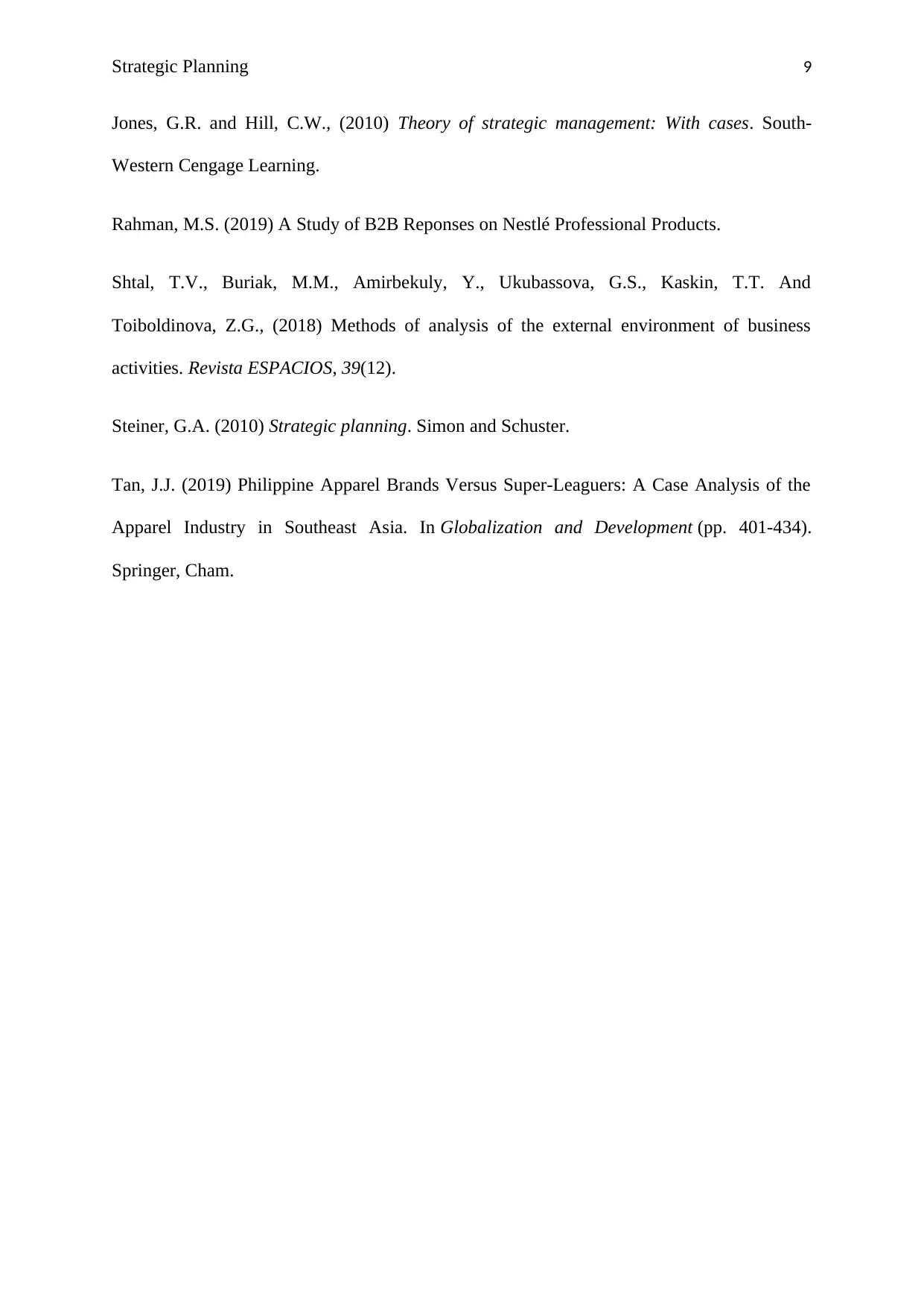
Strategic Planning 9
Jones, G.R. and Hill, C.W., (2010) Theory of strategic management: With cases. South-
Western Cengage Learning.
Rahman, M.S. (2019) A Study of B2B Reponses on Nestlé Professional Products.
Shtal, T.V., Buriak, M.M., Amirbekuly, Y., Ukubassova, G.S., Kaskin, T.T. And
Toiboldinova, Z.G., (2018) Methods of analysis of the external environment of business
activities. Revista ESPACIOS, 39(12).
Steiner, G.A. (2010) Strategic planning. Simon and Schuster.
Tan, J.J. (2019) Philippine Apparel Brands Versus Super-Leaguers: A Case Analysis of the
Apparel Industry in Southeast Asia. In Globalization and Development (pp. 401-434).
Springer, Cham.
Jones, G.R. and Hill, C.W., (2010) Theory of strategic management: With cases. South-
Western Cengage Learning.
Rahman, M.S. (2019) A Study of B2B Reponses on Nestlé Professional Products.
Shtal, T.V., Buriak, M.M., Amirbekuly, Y., Ukubassova, G.S., Kaskin, T.T. And
Toiboldinova, Z.G., (2018) Methods of analysis of the external environment of business
activities. Revista ESPACIOS, 39(12).
Steiner, G.A. (2010) Strategic planning. Simon and Schuster.
Tan, J.J. (2019) Philippine Apparel Brands Versus Super-Leaguers: A Case Analysis of the
Apparel Industry in Southeast Asia. In Globalization and Development (pp. 401-434).
Springer, Cham.
1 out of 10
Related Documents
Your All-in-One AI-Powered Toolkit for Academic Success.
+13062052269
info@desklib.com
Available 24*7 on WhatsApp / Email
![[object Object]](/_next/static/media/star-bottom.7253800d.svg)
Unlock your academic potential
Copyright © 2020–2025 A2Z Services. All Rights Reserved. Developed and managed by ZUCOL.





